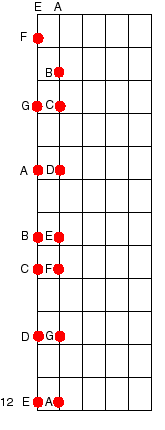Learning The Guitar Fretboard
Your Guide to Learning the Guitar Fretboard, memorize and understand notes on the fretboard...
Beginner Guitar Lesson - Learning the Fretboard
Open up new worlds in your guitar playing
In order to move beyond playing simple "open chords" (chords that involve playing open strings), we must first take care of a few necessities; learning note names on the sixth and fifth strings. There are several ways to go about doing this...
It is important for all musicians to undertand the way the "musical alphabet" works. The musical alphabet is similar in many respects to the "regular" alphabet, in that it uses standard letters (a, b, c...). Where the musical alphabet differs, is that in the musical alphabet, the letters only progress up to G, upon which, they begin again at A. As you continue up the musical alphabet, the pitches of the notes get higher (when you go past G up to A again, the notes continue to get higher, they don't start at a low pitch again.)
On the guitar, each of these letter names represents a specific fret on the fretboard. Between each letter name, there is a "blank" fret (these are the sharps and flats, which we'll deal with in a later lesson) WITH TWO EXCEPTIONS.
Between the notes B and C, and also between the notes E and F, there is no "blank" fret; these notes directly follow each other on the fretboard. This is visible in the diagram of the guitar fretboard below.

As you can see, the note F directly follows the note E on the sixth string of the guitar (the sixth string is referred to as the "E string" because that is the letter name of the open string.) As you continue up the string, you'll see that the notes G and A are separated by a blank fret, as are A and B. This is when we encounter the other exception; the note C directly follows B on the fretboard. Between C and D, there is a blank fret, as there also is between D and E. You've now worked your way up to the 12th fret of the guitar, and are back at the letter E again.
The counting process is the exact same on the fifth string (the "A string") as it was on the sixth string. Try working up the string without looking at the diagram, saying out loud each letter name until you've reached the 12th fret, at which point you should be back at the letter A again. Remember: no space between B and C, and also between E and F.
I have found that the best way to go about learning the fretboard is to start by committing several note names and frets to memory on each string. For example, if you've memorized that, on the sixth string, A is at the 5th fret, and C is at the 8th fret, if you are required to find the note D, instead of counting all the way up from the open string (E), you can count up 2 frets from C, because you know it is at the 8th. This makes things much quicker. As time progresses, you will naturally start to remember where all the other notes are.
Eventually, it will become necessary to learn note names on all six strings, but for now, we'll focus on just the sixth and fifth strings, because these become immediately useful when you start to deal with barre chords.
Best of luck! Take it slowly, be thorough, and enjoy it! Playing guitar is supposed to be fun.
From Dan Cross,
Your Guide to Guitar.
Go Back To Top Of Learning The Guitar Fretboard



